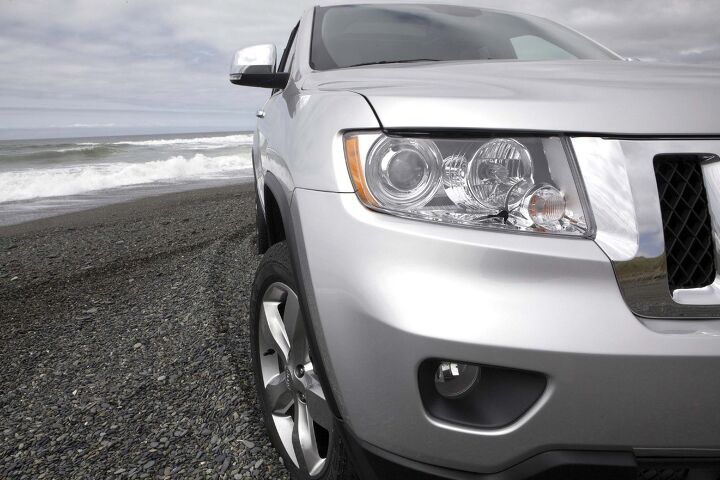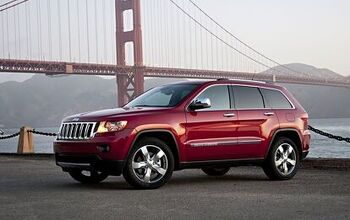Review: 2011 Jeep Grand Cherokee Take Two
Following the disastrous launch of the Chrysler Pacifica, which was supposed to take that brand upscale, Chrysler (the company, not the brand) did a 180 and started developing the cheapest, least refined, and least attractive vehicles sold in the U.S. End result: Chapter 11. But even before the bankruptcy Chrysler once again changed course, and set about developing more stylish, better-outfitted vehicles. The 2011 Jeep Grand Cherokee is the first of these. How good is it?
The new Jeep Grand Cherokee is considerably larger than the old one, with a wheelbase of 114.8 inches (up 5.3), a length of 189.8 inches (up 3.2), a width of 76.3 inches (up 3.0) and a height of 69.4 inches (up 1.7). The new body is rounder and smoother, but still far from generic. Especially given that the new SUV is based on the Mercedes ML, Chrysler did an outstanding job creating an exterior design that is both clearly a Grand Cherokee and thoroughly up-to-date, with athletic proportions (the wheelbase grew more than the length) and no trendy details to mar the clean, muscular bodysides. The interior design is almost as successful, with a similarly clean design, tight fits, and higher quality materials than in the 2010. “Almost” because the interior design is somewhat generic and, even in the most expensive trim levels, increasingly passe silver plastic trim covers the center stack and center console. Certainly Chrysler’s designers can come up with something better than this trim, and few parts are cheaper to alter.
The seats are high and comfortable, with a large, moderately raked windshield contributing to an excellent driving position. Compared to that in a Toyota 4Runner, with its upright windshield, the view forward in the Grand Cherokee is like that in a car, just much higher off the ground. One oddity: the A-pillars bow inward to an unusually large degree at the top and bottom, so the shape of the windshield is like that of an old television. Thanks to larger exterior the rear seat is much roomier than before, so adults now have plenty of room for their heads, shoulders, and legs. Cargo volume is about the same as before. Plenty for most uses, but you’ll find more in other SUVs.
Two engines are offered so far, a 290-horsepower 3.6-liter “Pentastar” V6 and a 360-horsepower 5.7-liter “Hemi” V8. The Pentastar will replace older V6s in many Chrysler, Dodge, and Jeep models during the 2011 model year, but it was introduced in the new Grand Cherokee. Not the best introduction. Though the new 3.6 is a fine engine, with very good power and refinement for its size, in the all-wheel-drive Jeep it’s saddled with 4,660 pounds of curb weight (up about 200). An antiquated five-speed automatic doesn’t help; a transmission with more ratios could provide a shorter first gear. An eight-speed automatic is likely on the way. Until it arrives, the V6 Grand Cherokee feels sluggish at low speeds and never feels quick. As hard as it would once have been to imagine, 290 horsepower seem merely adequate. The V8 feels considerably more energetic, but still isn’t quick, with 0-60 times similar to those for the V6-powered Toyota 4Runner. The Hemi could also sound more special; in the new Grand Cherokee they’ve muffled it overly much.
The new Grand Cherokee employs a sophisticated all-independent suspension based on a Mercedes design, so it should come as no surprise that it handles and rides much better than any previous Grand Cherokee save the SRT8, with excellent on-road body control and little noise. On paved roads the more softly suspended Toyota 4Runner feels squishy and imprecise in comparison. But the Jeep’s mass and high center of gravity cannot entirely be avoided—it leans more in turns than the typical car-based crossover. The new Grand Cherokee might be a very refined SUV, but it is still an SUV. Though less than in past Jeeps the steering is light and numb, and on-pavement driving is far from engaging. By which I mean it’s very pleasant, but boring. With Jeep developing ever more luxurious versions of the Grand Cherokee, with a new Overland Summit recently introduced at the 2011 North American International Auto Show (NAIAS), Lexus has far more to worry about than BMW. So far. SRT worked wonders with the chassis of the previous Grand Cherokee, and the new one provides a much better starting point. I’ve seen an SRT prototype around, so a new SRT8 is coming.
I did not drive either Grand Cherokee off the pavement [Ed: Despite what the press shots might have you believe], so cannot report how well it performs there. Jack Baruth’s press launch review suggests that, despite the Mercedes underpinnings, off-road performance remains worthy of the Jeep name, especially when equipped with the optional adjustable-height air suspension (also Mercedes-derived).
Even a minimally optioned 2011 Grand Cherokee with the V8 lists for $38,490, and it’s easy to configure one deep into the forties. Compared to the 2010, prices are up about $1,800, but the content level is up even more. Adjust for these additional features using TrueDelta’s car price comparisons. and the 2011 is actually $2,800 to $4,500 less pricey than the 2010, depending on trim level. These comparisons do not consider incentives, which were much higher with the 2010. More of a surprise: the 2011 Grand Cherokee V6 is about $4,000 less than a Toyota 4Runner or the even heavier new Ford Explorer when these are comparably loaded up. Though initially the prices might seem high, on closer examination Chrysler has priced the new Grand Cherokee aggressively.
I’ll be the first to admit that people don’t buy the Jeep Grand Cherokee for driving excitement. The things people do buy it for—style, luxury, the promise of off-road capability—have all been substantially improved with the 2011. Most impressive of all, the Grand Cherokee now has the look and feel of a premium vehicle, without a premium price. If you want these things, but also want to be thrilled by the driving experience, just wait for the SRT8.
Michael Karesh operates TrueDelta, an online source of automotive pricing and reliability data
Michael Karesh lives in West Bloomfield, Michigan, with his wife and three children. In 2003 he received a Ph.D. from the University of Chicago. While in Chicago he worked at the National Opinion Research Center, a leader in the field of survey research. For his doctoral thesis, he spent a year-and-a-half inside an automaker studying how and how well it understood consumers when developing new products. While pursuing the degree he taught consumer behavior and product development at Oakland University. Since 1999, he has contributed auto reviews to Epinions, where he is currently one of two people in charge of the autos section. Since earning the degree he has continued to care for his children (school, gymnastics, tae-kwan-do...) and write reviews for Epinions and, more recently, The Truth About Cars while developing TrueDelta, a vehicle reliability and price comparison site.
More by Michael Karesh
Latest Car Reviews
Read moreLatest Product Reviews
Read moreRecent Comments
- Tassos Under incompetent, affirmative action hire Mary Barra, GM has been shooting itself in the foot on a daily basis.Whether the Malibu cancellation has been one of these shootings is NOT obvious at all.GM should be run as a PROFITABLE BUSINESS and NOT as an outfit that satisfies everybody and his mother in law's pet preferences.IF the Malibu was UNPROFITABLE, it SHOULD be canceled.More generally, if its SEGMENT is Unprofitable, and HALF the makers cancel their midsize sedans, not only will it lead to the SURVIVAL OF THE FITTEST ones, but the survivors will obviously be more profitable if the LOSERS were kept being produced and the SMALL PIE of midsize sedans would yield slim pickings for every participant.SO NO, I APPROVE of the demise of the unprofitable Malibu, and hope Nissan does the same to the Altima, Hyundai with the SOnata, Mazda with the Mazda 6, and as many others as it takes to make the REMAINING players, like the Excellent, sporty Accord and the Bulletproof Reliable, cheap to maintain CAMRY, more profitable and affordable.
- GregLocock Car companies can only really sell cars that people who are new car buyers will pay a profitable price for. As it turns out fewer and fewer new car buyers want sedans. Large sedans can be nice to drive, certainly, but the number of new car buyers (the only ones that matter in this discussion) are prepared to sacrifice steering and handling for more obvious things like passenger and cargo space, or even some attempt at off roading. We know US new car buyers don't really care about handling because they fell for FWD in large cars.
- Slavuta Why is everybody sweating? Like sedans? - go buy one. Better - 2. Let CRV/RAV rust on the dealer lot. I have 3 sedans on the driveway. My neighbor - 2. Neighbors on each of our other side - 8 SUVs.
- Theflyersfan With sedans, especially, I wonder how many of those sales are to rental fleets. With the exception of the Civic and Accord, there are still rows of sedans mixed in with the RAV4s at every airport rental lot. I doubt the breakdown in sales is publicly published, so who knows... GM isn't out of the sedan business - Cadillac exists and I can't believe I'm typing this but they are actually decent - and I think they are making a huge mistake, especially if there's an extended oil price hike (cough...Iran...cough) and people want smaller and hybrids. But if one is only tied to the quarterly shareholder reports and not trends and the big picture, bad decisions like this get made.
- Wjtinfwb Not proud of what Stellantis is rolling out?







































Comments
Join the conversation
The new 3.6 is a great engine. Give it some time to break in and it will reward with good power and fuel mileage. The number of speeds in the tranny are really irrelavant. These silly 7 and 8 speed trannys are overkill with the engine constantly shifting and revving all over the place which is very annoying and not necessary if the engine is designed with good torque characteristics. My old 4 speed 4T65 in my 2008 Impala shifts better than most any new car I have rented or test driven with prefect on time often not felt shifts. The major issue with it is the large gap between first and second gear which any good 5 or 6 speed improves on if the gear ratios are properly chosen and the computer is properly programmed for shift quality. I don't see a need for 8 speeds in an automatic with todays power levels.
Can we get a comments filter which automatically erases any post containing the string "obama"?